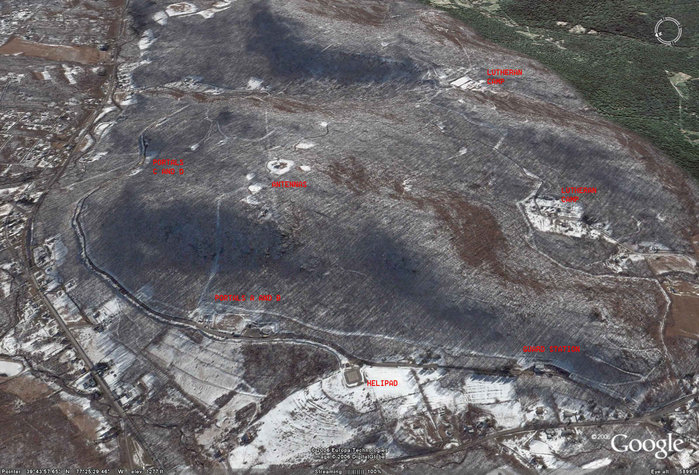 Japan Focus
Japan FocusIn July 1987, during the Iran-Contra Hearings grilling of Oliver North, the American public got a glimpse of "highly sensitive" emergency planning North had been involved in. Ostensibly these were emergency plans to suspend the American constitution in the event of a nuclear attack (a legitimate concern). But press accounts alleged that the planning was for a more generalized suspension of the constitution.
As part of its routine Iran-contra coverage, the following exchange was printed in the New York Times, but without journalistic comment or follow-up:
[Congressman Jack] Brooks: Colonel North, in your work at the N.S.C. were you not assigned, at one time, to work on plans for the continuity of government in the event of a major disaster?
Both North's attorney and Sen. Daniel Inouye, the Democratic Chair of the Committee, responded in a way that showed they were aware of the issue:
Brendan Sullivan [North's counsel, agitatedly]: Mr. Chairman?
[Senator Daniel] Inouye: I believe that question touches upon a highly sensitive and classified area so may I request that you not touch upon that?
Brooks: I was particularly concerned, Mr. Chairman, because I read in Miami papers, and several others, that there had been a plan developed, by that same agency, a contingency plan in the event of emergency, that would suspend the American constitution. And I was deeply concerned about it and wondered if that was an area in which he had worked. I believe that it was and I wanted to get his confirmation.
Inouye: May I most respectfully request that that matter not be touched upon at this stage. If we wish to get into this, I'm certain arrangements can be made for an executive session.1
But we have never heard if there was or was not an executive session, or if the rest of Congress was ever aware of the matter. According to James Bamford, "The existence of the secret government was so closely held that Congress was completely bypassed."2 (Key individuals in Congress were almost certainly aware.)
Brooks was responding to a story by Alfonzo Chardy in the Miami Herald. Chardy's story alleged that Oliver North was involved with the Federal Emergency Management Agency (FEMA) in plans to take over federal, state and local functions during a national emergency. This planning for "Continuity of Government" (COG) called for "suspension of the Constitution, turning control of the government over to the Federal Emergency Management Agency, emergency appointment of military commanders to run state and local governments and declaration of martial law."3
To my knowledge no one in the public (including myself) attached enough importance to the Chardy story. Chardy himself suggested that Reagan's Attorney General, William French Smith, had intervened to stop the COG plan from being presented to the President. Seven years later, in 1994, Tim Weiner reported in the New York Times that what he called "The Doomsday Project" -- the search for "ways to keep the Government running after a sustained nuclear attack on Washington" -- had "less than six months to live."4
To say that nuclear attack planning was over was correct, But this statement was also very misleading. On the basis of Weiner's report, the first two books on COG planning, by James Bamford and James Mann, books otherwise excellent and well-informed, reported that COG planning had been abandoned.5 They were wrong.
Mann and Bamford did report that, from the beginning, two of the key COG planners on the secret committee were Dick Cheney and Donald Rumsfeld, the two men who implemented COG under 9/11.6 What they and Weiner did not report was that under Reagan the purpose of COG planning had officially changed: it was no longer for arrangements "after a nuclear war," but for any "national security emergency." This was defined in Executive Order 12656 of 1988 as: "any occurrence, including natural disaster, military attack, technological emergency, or other emergency, that seriously degrades or seriously threatens the national security of the United States."7
In other words extraordinary emergency measures, originally designed for an America devastated in a nuclear attack, were now to be applied to anything the White House considered an emergency. Thus Cheney and Rumsfeld continued their secret planning when Clinton was president; both men, both Republicans, were heads of major corporations and not even in the government at that time. Moreover, Andrew Cockburn claims that the Clinton administration, according to a Pentagon source, had "no idea what was going on."8 (As I shall explain later, this sweeping claim needs some qualification.)
The expanded application of COG to any emergency was envisaged as early as 1984, when, according to Boston Globe reporter Ross Gelbspan,
Lt. Col. Oliver North was working with officials of the Federal Emergency Management Agency . . . to draw up a secret contingency plan to surveil political dissenters and to arrange for the detention of hundreds of thousands of undocumented aliens in case of an unspecified national emergency. The plan, part of which was codenamed Rex 84, called for the suspension of the Constitution under a number of scenarios, including a U.S. invasion of Nicaragua.9
Clearly 9/11 met the conditions for the imposition of COG measures, and we know for certain that COG planning was instituted on that day in 2001, before the last plane had crashed in Pennsylvania. The 9/11 Report confirms this twice, on pages 38 and 326.10 It was under the auspices of COG that Bush stayed out of Washington on that day, and other government leaders like Paul Wolfowitz were swiftly evacuated to Site R, inside a hollowed out mountain near Camp David.11
| Site R, Raven Rock Complex |
What few have recognized is that, nearly a decade later, some aspects of COG remain in effect. COG plans are still authorized by a proclamation of emergency that has been extended each year by presidential authority, most recently by President Obama in September 2009. COG plans are also the probable source for the 1000-page Patriot Act presented to Congress five days after 9/11, and also for the Department of Homeland Security's Project Endgame -- a ten-year plan, initiated in September 2001, to expand detention camps, at a cost of $400 million in Fiscal Year 2007 alone.12
At the same time we have seen the implementation of the plans outlined by Chardy in 1987: the warrantless detentions that Oliver North had planned for in Rex 1984, the warrantless eavesdropping that is their logical counterpart, and the militarization of the domestic United States under a new military command, NORTHCOM.13 Through NORTHCOM the U.S. Army now is engaged with local enforcement to control America, in the same way that through CENTCOM it is engaged with local enforcement to control Afghanistan and Iraq.
| Northcom. US Northern Command Headquarters at Peterson Air Force Base, Colorado |
We learned that COG planning was still active in 2007, when President Bush issued National Security Presidential Directive 51 (NSPD 51). This, for the sixth time, extended for one year the emergency proclaimed on September 14, 2001. It empowered the President to personally ensure "continuity of government" in the event of any "catastrophic emergency." He announced that NSPD 51 contains "classified Continuity Annexes" which shall "be protected from unauthorized disclosure." Under pressure from his 911truth constituents, Congressman Peter DeFazio of the Homeland Security Committee twice requested to see these Annexes, the second time in a letter signed by the Chair of his committee. His request was denied.
The National Emergencies Act, one of the post-Watergate reforms that Vice-President Cheney so abhorred, specifies that: "Not later than six months after a national emergency is declared, and not later than the end of each six-month period thereafter that such emergency continues, each House of Congress shall meet to consider a vote on a joint resolution to determine whether that emergency shall be terminated" (50 U.S.C. 1622, 2002). Yet in nine years Congress has not once met to discuss the State of Emergency declared by George W. Bush in response to 9/11, a State of Emergency that remains in effect today. Appeals to the Congress to meet its responsibilities to review COG have fallen on deaf ears.14
Former Congressman Dan Hamburg and I appealed publicly last year, both to Obama to terminate the emergency, and to Congress to hold the hearings required of them by statute.15 But Obama, without discussion, extended the 9/11 Emergency again on September 10, 2009;16 and Congress has continued to ignore its statutory obligations. One Congressman explained to a constituent that the provisions of the National Emergencies Act have now been rendered inoperative by COG. If true, this would seem to justify Chardy's description of COG as suspension of the Constitution.
Continued


No comments:
Post a Comment